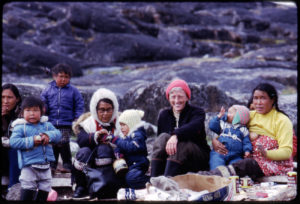
For more than 30 years, the Inuit welcomed anthropologist Jean Briggs into their lives so she could study how they raise their children. Briggs is pictured during a 1974 visit to Baffin Island. Jean Briggs Collection / American Philosophical Society
How Inuit Parents Teach Kids To Control Their Anger
Michaeleen Doucleff and Jane Greenhalgh, NPR, March 13, 2019
Back in the 1960s, a Harvard graduate student made a landmark discovery about the nature of human anger.
At age 34, Jean Briggs traveled above the Arctic Circle and lived out on the tundra for 17 months. There were no roads, no heating systems, no grocery stores. Winter temperatures could easily dip below minus 40 degrees Fahrenheit.
Briggs persuaded an Inuit family to “adopt” her and “try to keep her alive,” as the anthropologist wrote in 1970.
At the time, many Inuit families lived similar to the way their ancestors had for thousands of years. They built igloos in the winter and tents in the summer. “And we ate only what the animals provided, such as fish, seal and caribou,” says Myna Ishulutak, a film producer and language teacher who lived a similar lifestyle as a young girl.
Briggs quickly realized something remarkable was going on in these families: The adults had an extraordinary ability to control their anger.
“They never acted in anger toward me, although they were angry with me an awful lot,” Briggs told the Canadian Broadcasting Corp. in an interview.
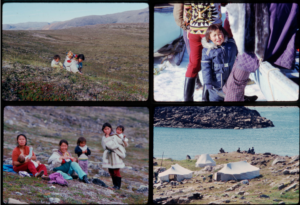
Myna Ishulutak (upper right, in blue jacket) lived a seminomadic life as a child. Above: photos of the girl and her family in the hunting camp of Qipisa during the summer of 1974. Jean Briggs Collection / American Philosophical Society
Even just showing a smidgen of frustration or irritation was considered weak and childlike, Briggs observed.
For instance, one time someone knocked a boiling pot of tea across the igloo, damaging the ice floor. No one changed their expression. “Too bad,” the offender said calmly and went to refill the teapot.
In another instance, a fishing line — which had taken days to braid — immediately broke on the first use. No one flinched in anger. “Sew it together,” someone said quietly.
By contrast, Briggs seemed like a wild child, even though she was trying very hard to control her anger. “My ways were so much cruder, less considerate and more impulsive,” she told the CBC. “[I was] often impulsive in an antisocial sort of way. I would sulk or I would snap or I would do something that they never did.”
Briggs, who died in 2016, wrote up her observations in her first book, Never in Anger. But she was left with a lingering question: How do Inuit parents instill this ability in their children? How do Inuit take tantrum-prone toddlers and turn them into cool-headed adults?
Then in 1971, Briggs found a clue.
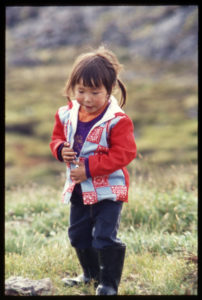
Inuit filmmaker and language teacher Myna Ishulutak as a little girl. Anthropologist Jean Briggs spent six months with the family in the 1970s documenting the child’s upbringing. Jean Briggs Collection / American Philosophical Society
She was walking on a stony beach in the Arctic when she saw a young mother playing with her toddler — a little boy about 2 years old. The mom picked up a pebble and said, “‘Hit me! Go on. Hit me harder,'” Briggs remembered.
The boy threw the rock at his mother, and she exclaimed, “Ooooww. That hurts!”
Briggs was completely befuddled. The mom seemed to be teaching the child the opposite of what parents want. And her actions seemed to contradict everything Briggs knew about Inuit culture.
“I thought, ‘What is going on here?’ ” Briggs said in the radio interview.
Turns out, the mom was executing a powerful parenting tool to teach her child how to control his anger — and one of the most intriguing parenting strategies I’ve come across.
No scolding, no timeouts
It’s early December in the Arctic town of Iqaluit, Canada. And at 2 p.m., the sun is already calling it a day. Outside, the temperature is a balmy minus 10 degrees Fahrenheit. A light snow is swirling.
I’ve come to this seaside town, after reading Briggs’ book, in search of parenting wisdom, especially when it comes to teaching children to control their emotions. Right off the plane, I start collecting data.
I sit with elders in their 80s and 90s while they lunch on “country food” —stewed seal, frozen beluga whale and raw caribou. I talk with moms selling hand-sewn sealskin jackets at a high school craft fair. And I attend a parenting class, where day care instructors learn how their ancestors raised small children hundreds — perhaps even thousands — of years ago.
Across the board, all the moms mention one golden rule: Don’t shout or yell at small children.
Traditional Inuit parenting is incredibly nurturing and tender. If you took all the parenting styles around the world and ranked them by their gentleness, the Inuit approach would likely rank near the top. (They even have a special kiss for babies, where you put your nose against the cheek and sniff the skin.)
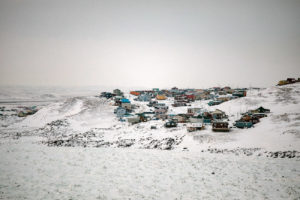
Iqaluit, pictured in winter, is the capital of the Canadian territory of Nunavut. Johan Hallberg-Campbell for NPR
The culture views scolding — or even speaking to children in an angry voice — as inappropriate, says Lisa Ipeelie, a radio producer and mom who grew up with 12 siblings. “When they’re little, it doesn’t help to raise your voice,” she says. “It will just make your own heart rate go up.”
Even if the child hits you or bites you, there’s no raising your voice?
“No,” Ipeelie says with a giggle that seems to emphasize how silly my question is. “With little kids, you often think they’re pushing your buttons, but that’s not what’s going on. They’re upset about something, and you have to figure out what it is.”
Traditionally, the Inuit saw yelling at a small child as demeaning. It’s as if the adult is having a tantrum; it’s basically stooping to the level of the child, Briggs documented.
Elders I spoke with say intense colonization over the past century is damaging these traditions. And, so, the community is working hard to keep the parenting approach intact.
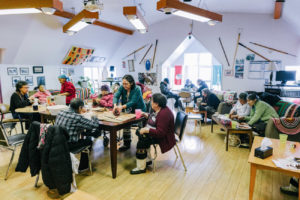
The elders of Iqaluit have lunch at the local senior center. On Thursdays, what they call “country food” is on the menu, things like caribou, seal and ptarmigan. Johan Hallberg-Campbell for NPR
Goota Jaw is at the front line of this effort. She teaches the parenting class at the Arctic College. Her own parenting style is so gentle that she doesn’t even believe in giving a child a timeout for misbehaving.
“Shouting, ‘Think about what you just did. Go to your room!’ ” Jaw says. “I disagree with that. That’s not how we teach our children. Instead you are just teaching children to run away.”
And you are teaching them to be angry, says clinical psychologist and author Laura Markham. “When we yell at a child — or even threaten with something like ‘I’m starting to get angry,’ we’re training the child to yell,” says Markham. “We’re training them to yell when they get upset and that yelling solves problems.”
In contrast, parents who control their own anger are helping their children learn to do the same, Markham says. “Kids learn emotional regulation from us.”
I asked Markham if the Inuit’s no-yelling policy might be their first secret of raising cool-headed kids. “Absolutely,” she says.
Playing soccer with your head
Now at some level, all moms and dads know they shouldn’t yell at kids. But if you don’t scold or talk in an angry tone, how do you discipline? How do you keep your 3-year-old from running into the road? Or punching her big brother?
For thousands of years, the Inuit have relied on an ancient tool with an ingenious twist: “We use storytelling to discipline,” Jaw says.
Jaw isn’t talking about fairy tales, where a child needs to decipher the moral. These are oral stories passed down from one generation of Inuit to the next, designed to sculpt kids’ behaviors in the moment. Sometimes even save their lives.
For example, how do you teach kids to stay away from the ocean, where they could easily drown? Instead of yelling, “Don’t go near the water!” Jaw says Inuit parents take a pre-emptive approach and tell kids a special story about what’s inside the water. “It’s the sea monster,” Jaw says, with a giant pouch on its back just for little kids.
“If a child walks too close to the water, the monster will put you in his pouch, drag you down to the ocean and adopt you out to another family,” Jaw says.
“Then we don’t need to yell at a child,” Jaw says, “because she is already getting the message.”
Inuit parents have an array of stories to help children learn respectful behavior, too. For example, to get kids to listen to their parents, there is a story about ear wax, says film producer Myna Ishulutak.

Inuit parenting is gentle and tender. They even have a special kiss for kids called kunik. (Above) Maata Jaw gives her daughter the nose-to-cheek Inuit sniff. Johan Hallberg-Campbell for NPR
“My parents would check inside our ears, and if there was too much wax in there, it meant we were not listening,” she says.
And parents tell their kids: If you don’t ask before taking food, long fingers could reach out and grab you, Ishulutak says.
Then there’s the story of northern lights, which helps kids learn to keep their hats on in the winter.
“Our parents told us that if we went out without a hat, the northern lights are going to take your head off and use it as a soccer ball,” Ishulutak says. “We used to be so scared!” she exclaims and then erupts in laughter.
At first, these stories seemed to me a bit too scary for little children. And my knee-jerk reaction was to dismiss them. But my opinion flipped 180 degrees after I watched my own daughter’s response to similar tales — and after I learned more about humanity’s intricate relationship with storytelling.
Oral storytelling is what’s known as a human universal. For tens of thousands of years, it has been a key way that parents teach children about values and how to behave.
Modern hunter-gatherer groups use stories to teach sharing, respect for both genders and conflict avoidance, a recent study reported, after analyzing 89 different tribes. With the Agta, a hunter-gatherer population of the Philippines, good storytelling skills are prized more than hunting skills or medicinal knowledge, the study found.
Today many American parents outsource their oral storytelling to screens. And in doing so, I wonder if we’re missing out on an easy — and effective — way of disciplining and changing behavior. Could small children be somehow “wired” to learn through stories?
(Read more…)

